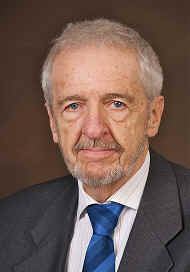Name Uffe Ravnskov Role Researcher | ||
 | ||
Books The Cholesterol Myths: Exposing the Fallacy that Cholesterol and Saturated Fat Cause Heart Disease | ||
Kolesterol hvad er myter fakta seminar med dr med uffe ravnskov
Uffe Ravnskov (born 1934) is a Danish independent researcher, a member of various international scientific organisations, and a former private medical practitioner in Sweden. In recent years he has gained notoriety for questioning the scientific consensus regarding the Lipid Hypothesis.
Contents
- Kolesterol hvad er myter fakta seminar med dr med uffe ravnskov
- The Questionable Benefits of Exchanging Saturated Fat With Polyunsaturated Fat
- Early career
- Research in Nephrology
- Investigation of the Lipid Hypothesis or Diet Heart Idea
- Awards and Organisations
- References
The Questionable Benefits of Exchanging Saturated Fat With Polyunsaturated Fat
Early career
He was born in Copenhagen, Denmark, and received his medical doctorate from the University of Copenhagen in 1961. Over the following seven years, he worked at various surgical, roentgenological, neurological, paediatric and medical departments in Denmark and Sweden. He then began scientific studies at the Departments of Nephrology and Clinical Chemistry at the Lund University Hospital in Lund, Sweden. He was awarded his doctorate of philosophy (specialising in internal medicine and nephrology) there in 1973, and was assistant professor at the university's Department of Nephrology from 1975 to 1979.
An encounter with scientific fraud committed by a colleague ended up changing Ravnskov's career:
Ravnskov entered private medical practice as a specialist in internal medicine and nephrology in 1979, and worked in Lund in this capacity and as a family doctor until retiring in 2000. Since 1979 he has worked as an independent scientific researcher and since 2000 continues to do so on a full-time basis.
He resides in Lund, Sweden.
Research in Nephrology
In his 1973 PhD. thesis, On Renal Handling of Serum Proteins, Ravnskov introduced the albumin/creatinine clearance ratio, a more accurate way to measure proteinuria. He was also the first to describe the peritubular uptake of low-molecular-weight proteins.
He also proposed a theory that glomerulonephritis is primarily a tubulointerstitial disease, supported by his earlier findings that most patients with glomerulonephritis excrete large amounts of tubular proteins and tubulospecific enzymes.
In experimental studies he demonstrated that the handling of proteins by the kidneys differs in man and other mammals, implying that knowledge from animal studies cannot be applied to humans.
Ravnskov also conducted work on urinary tract infections; in one study of urinary tract infections in women he found that the major cause of dysuria was soap, not bacteria.
His major research interest concerns the association between hydrocarbon exposure and glomerulonephritis; this interest was sparked by a 1975 paper in The Lancet by Stephen W. Zimmerman, K. Groehler, and G.J. Beirne, who found that the large majority of their patients with glomerulonephritis on dialysis treatment had prior heavy exposure to industrial solvents. In his subsequent work in this area, he was the first to demonstrate that a discontinuation of hydrocarbon exposure may improve the course of glomerulonephritis, a finding confirmed by follow-up studies made by British researchers.
Investigation of the Lipid Hypothesis, or "Diet-Heart" Idea
When the lipid hypothesis came to be promoted strongly in Sweden Ravnskov felt there was an incongruity between the Diet-Heart Idea and scientific literature he could recall. In Ravnskov's words,
He reexamined data from past scientific studies, and came to the conclusion that the scientific foundations of the Diet-Heart Idea were scientifically flawed, with what he characterized as all the "inaccuracies, misinterpretations, exaggerations and misleading quotations in this research area." His book Kolesterolmyten ("The Cholesterol Myths") was subsequently published in Sweden in 1991 and in Finland in 1992. It received adverse attention from the local media when they consulted the researchers and health authorities that it criticised; in the 2003 edition of the book, Ravnskov recalls how it was belittled in a television programme on Finland's Channel 2 television station and a copy of the book literally set on fire.
With the popularisation of the internet in the late 1990s, Ravnskov saw the opportunity to publicize his conclusion and, in 1997, published selected sections of The Cholesterol Myths on the world wide web. According to the search engine Direct Hit (since acquired by Ask.com in 1999), Ravnskov's website soon became ranked as one of the top ten most popular websites about cholesterol. As a result of this worldwide interest, his book was translated into English and published in the United States as The Cholesterol Myths: Exposing the Fallacy that Saturated Fat and Cholesterol cause Heart Disease in September 2000 by a publishing house established by the head of the Weston A. Price Foundation, Sally Fallon. It was later published in Germany in 2002 under the title Mythos Cholesterin. Die zehn größten Irrtümer ("Cholesterol Myth: The Ten Biggest Errors").
Since 1990, Ravnskov has published over 80 scientific papers critical of the Diet-Heart Idea, proposing new hypotheses and also contending that "the successful dissemination of the diet-heart idea is due to authors systematically ignoring or misquoting discordant (contradictory) studies". He was the first to suggest that the positive effect of the statins may be due to other effects than cholesterol-lowering.
Awards and Organisations
Ravnskov has received the Skrabanek Award in 1999 from Trinity College, Dublin, Ireland, for original contributions in the field of medical scepticism.
He is a member of the free panel of the Journal of the Swedish Medical Association (the medical journal Läkartidningen), the International Science Oversight Board, the International Society for the Study of Fatty Acids and Lipids, and is the spokesman for THINCS, The International Network of Cholesterol Skeptics.
